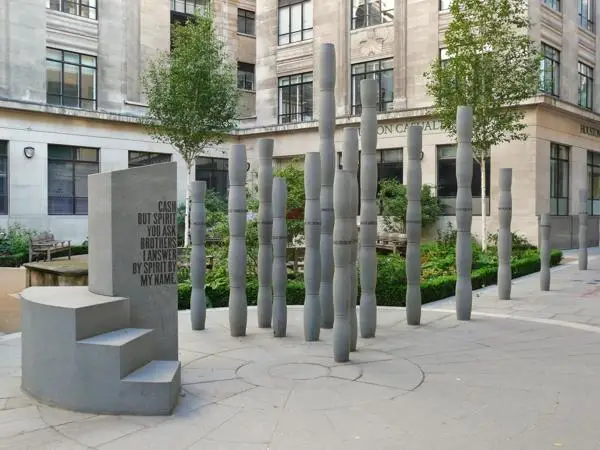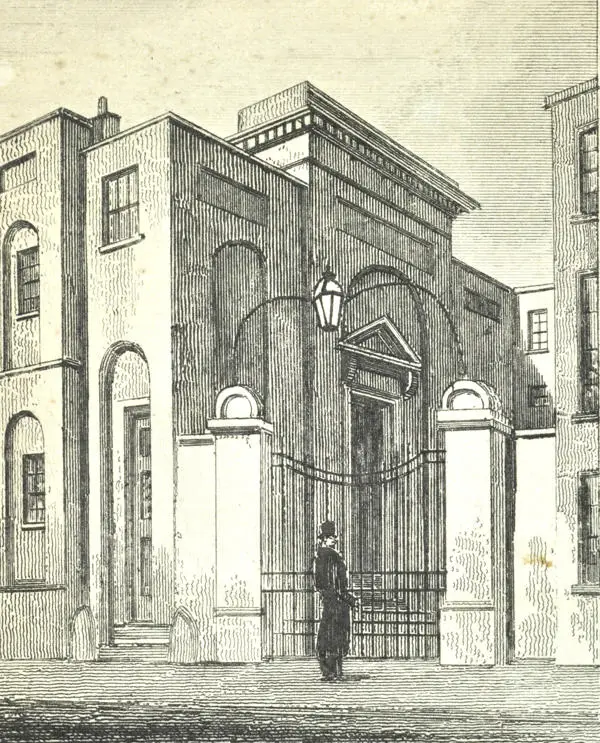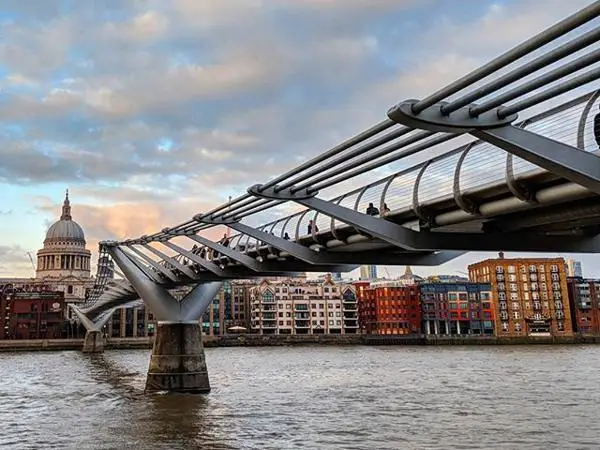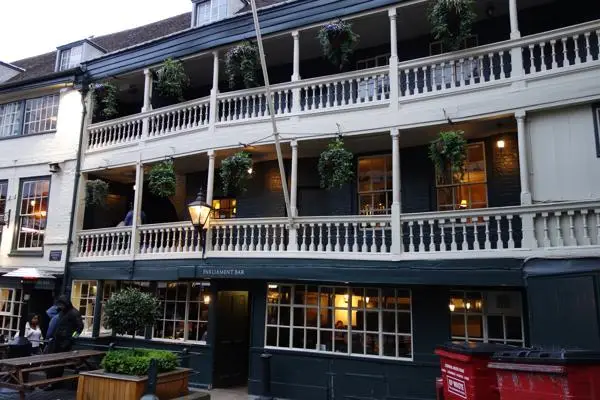The Mayflower, Merchants and Migration
The Pilgrim Fathers sailed from England onboard the Mayflower in 1620 in search of a new life. They were not the first migrants, nor the last; there have always been movements of people to and from Britain, but few have established themselves as firmly in our imaginations as they have. Who they were, why they went, where they came from, and how the City of London and Southwark had a part in their story is the subject of this walk. Their story, and the stories of others who left, are linked by common threads of persecution, fear, and determination. These stories continue to inspire hope, respect and admiration.
This self-guided walk will take around two hours, with opportunities for breaks and visits along the way. Download a PDF file of the walk below, or scroll down to read on the screen.
Start outside the Monument tube station on Fish Street Hill, walk south to Lower Thames Street, cross the road to the churchyard of St Magnus the Martyr.
St Magnus the Martyr, Lower Thames Street
The current church replaces one lost in the Great Fire 1666 where one of the chief organisers of the Mayflower expedition, James Sherley, worshipped. Sherley was a Merchant Adventurer, the organisation in the City of London which financed and organised the expedition, selected the Mayflower ship and her crew and also recruited 65 of the 102 passengers. Of these 65 were 35 members of the English Separatist Church (a radical faction of Puritanism) who had earlier fled to Leiden, the Netherlands, to escape persecution at home. Sherley had a goldsmith’s business on London Bridge. A plaque recording the bridge is in the churchyard. Sherley had contacts with Amsterdam through his trade. His support for the Pilgrims continued after they reached Massachusetts, being a staunch supporter of their venture, rather than simply interested in financial return.
Turn left out of the churchyard and cross Lower Thames Street by the Custom House and walk up St Dunstan’s Hill, cross Eastcheap into Mincing Lane, cross Fenchurch Street to Fen Court.
Fen Court
Ironmongers’ Hall was in Fenchurch Street until 1917. Ironmonger Thomas Weston mobilised the Merchant Adventurers to organise the expedition and recruited passengers for the Mayflower. He played an instrumental role in the lives of the More children, taken from their Shropshire home in 1616 in a dispute centring on their mother’s alleged adultery. After four years without contact with their mother, the children were taken to Weston’s home in London until the Mayflower was to sail. Only one of the four children, Richard More, survived the first harsh winter in Plymouth.
The sculpture and poem, Gilt of Cain by Michael Visocchi and Lemn Sissay, commemorate the abolition of the transatlantic slave trade in 1807, which began the process of the emancipation of slaves throughout the British Empire. Coincidentally, Ironmonger Thomas Betton, once a victim of pirates involved in the slave trade, left half his estate ‘for the redemption of British slaves in Turkey and Barbary’.
Leave Fen Court from the north side, turn right along Fenchurch Avenue, then left into Billiter Street and right onto Leadenhall Street where you will see the church of St Katharine Cree. Cross to Creechurch Lane where you will see a plaque recording the site of the first synagogue after the resettlement of Jews in the mid C17.

First synagogue after resettlement, Creechurch Lane
The Spanish and Portuguese Jews’ Congregation of London traces its origin back to the Petition presented to Oliver Cromwell in 1656 by Rabbi Menasseh Ben Israel, from Holland, and six of the ‘secret Jews’ (Marranos) living in London. For the first time since the1290 expulsion, Jews were able to live and worship openly in England. They quickly set up a synagogue in a rented house in Creechurch Lane The Congregation grew steadily and a large new synagogue was built. Pilgrims in Amsterdam had strong links with the Jewish community. In London Henry Jessey, a leader of the Pilgrim Church, and minister at St George the Martyr in Southwark, many of whose congregation fled to New England, lobbied for the rights of Jews and their readmission to England.
Continue along Creechurch lane and turn left into Heneage Lane.
Site of Heneage House
This was the organising hub of the Mayflower expedition. The house here, described as a ‘great house, large of rooms’ was where the Pilgrim leaders Bradford, Cushman, Mitchell and Southworth lived and perhaps even planned the Mayflower venture. It is possible that this site is more worthy of remembrance than the quays of Southampton and Portsmouth where the Mayflower ship stopped briefly. A letter from Robert Cushman to Heneage House still exists. The house was owned by the Finch family, many of whom had the Christian name ‘Heneage’.

Bevis Marks Synagogue
The brick wall here is part of the Bevis Marks Synagogue. Built by the Quaker, Joseph Avis and modelled, in many respects, on the Great Synagogue in Amsterdam. The synagogue was opened in 1701 and is the only synagogue in Europe to have held continuous worship for 300 years.
Continue along Heneage Lane and turn left at the top. You will see Bevis Marks Synagogue through the archway on the left. Go straight over the crossroads (Bishopsgate) and turn left into Old Broad Street. Take the first road on the right, Great Winchester Street. Just before the road bends right, take the alleyway on the left.
The church was founded by King Edward VI in 1550 for ‘strangers’, foreign refugees. In practice, this was the church for Dutch refugees as there was already a church for Huguenot refugees nearby. This building dates from 1954 as the original was destroyed in 1940. Names of ministers are carved inside and include Simon Ruytinck who was minister in 1620-1 and a friend of John Robinson, the pastor of the pilgrims. People who came from Leiden would have been welcomed here.Turn right, walking around the church, you will see an entrance to Drapers Hall in front of you. At the end of the road, turn right into Old Broad Street, cross the road at the end. Turn right and you will see the Royal Exchange on your left.
Statue of Thomas Gresham, rear of Royal Exchange
Gresham (1519-1579) was the founder of the first Royal Exchange as a centre of commerce in the City. Originally called a bourse after the bourse in Antwerp where Gresham worked a merchant and financier, it was a trading floor. Throughout the reigns of James I and Charles I religion was a strong motive to emigrate. Increasing numbers of Puritans, dissatisfied with the established church, and persecuted for their beliefs, emigrated to the Netherlands where they could worship and raise their families according to their conscience. When they decided to try their luck elsewhere some London financiers agreed to support a project for a settlement in America. The Mayflower expedition was the result. The bulk were not Puritans, but people seeking opportunities for a new life and land of their own.
Retrace your steps to Threadneedle Street, cross and walk down Bartholomew Lane beside the Bank of England, turning left at the end into Lothbury, then right into Coleman Lane. You will see a plaque marking the site of St Stephen’s Church.
Plaque, Coleman Street St Stephen’s Church
This church had links to the Pilgrim Church in Southwark. It was one of 13 radical parishes which elected its own vicar. Henry Jessey, lived in nearby Swan Alley for a time. He is also said to have taken ‘oversight’ of the Baptist church in the parish of St Stephen.
Turn left Mason’s Avenue, cross Guildhall Street to Guildhall Yard.
The Guildhall
This is the heart of the City. There has been a meeting place here since Roman times, the Roman Amphitheatre is beneath your feet. The Guildhall itself, the building with the flagpole, is where the people who govern the City have met since the C15. The Lord Mayor of the City is elected here and in the past trials were held here, too. Inside, there are shields and flags celebrating all 110 of the existing livery companies. The Guildhall Art Gallery here has a fantastic resource of paintings on London topics, including portraits of many of the people involved in the Mayflower story.
Leave Guildhall Yard via exit at rear of St Lawrence Jewry, cross Gresham Street into Ironmonger Lane to the rear of Mercers’ Hall.
The Mercers are the most important of the City livery companies. Gresham was a Mercer, and the symbol of the demi-vierge displayed on this building can also be seen at the Royal Exchange. As powerful traders, many were also members of the Merchant Adventurers, the group of investors whose capital funded the Pilgrims journey on the Mayflower. They invested in a joint-stock company through which they hoped to make a profit from the fur trade, from fishing, plus any further opportunities that should present themselves. It was in the Mercers’ Hall that the Merchant Adventurers first met. The current building dates from 1958, the building that replaced one lost in the Great Fire having been blitzed in 1941 and rebuilt.
Turn right onto Cheapside and cross the road to Bow Churchyard.
Bow Churchyard
The spectacular tower of St Mary le Bow was designed by Sir Christopher Wren following the Great Fire of London in 1666. The rest of the church was rebuilt following the blitz. John Smith, whose statue is here, preached a sermon in the church to promote settlement in the New World. He mapped the New World coast in 1614 and it is likely that it was his map, with Plymouth marked on it, which was used by Christopher Jones, Captain of the Mayflower. Today, the parish of All Hallows, Bread Street is incorporated into St Mary le Bow. John Pocock a Merchant Adventurer, who invested in the Mayflower, worshipped here. He also recruited Miles Standish to be the military leader of the expedition so it is possible he also lived nearby. John Carver, a Pilgrim leader, was deacon of St Pancras, Soper Lane, the parish of which is also incorporated in this church.
Leave via Milton Passage, turn left down Bread Street to junction with Cannon Street, cross and continue along Bread Street to junction with Queen Victoria Street , turn right. Continue to junction with St Peter’s Hill, cross the road and walk towards the Millennium Bridge.
The Millennium Bridge and the River ThamesIn 1620 the river would have been busy with shipping and trade, bearing every kind of merchandise. Only one bridge straddled the Thames, London Bridge. People cast fishing lines into the water; boatmen used boathooks to catch hold of rings set in the walls of the bridge’s piers. On the south side of the river is Bankside, infamous in the C17 as a ‘naughty place’ of theatres, brothels, bearbaiting. People were ferried from one side to the other by watermen. Mayflower passenger John Billington of Southwark was recruited by Weston. Members of his family are said to be the only ones who did not fall seriously ill or die in the first harsh winter. A Billington descendant claims this was due to the family being hardened by Southwark germs. In 1630 he became the first colonist to be tried and executed for murder.
Cross the bridge and follow the river east to the Globe theatre.

The Globe Theatre
This is a recreation of the original Globe theatre, which was a short distance away to the south. This was the idea of Sam Wanamaker, an American director and actor who was passionate about restoring the Globe in its original location. Three plays by William Shakespeare have connections with the Mayflower Pilgrims: King Lear, The Tempest and Twelfth night. In the latter, Andrew Aguecheek says ‘I had as lief be a Brownist as a politician’. This refers to Robert Browne who was a Separatist whose books and preaching led to people with these views being described as ‘Brownists’. The other two plays have connections through the Virginia Company, one of the major trading companies of the City of London. The Earl of Southampton, Shakespeare’s patron, had connections with Sir Edwin Sandys who was active in this Company.
Continue along the riverfront to The Anchor public house.
The Anchor
The pub is a surviving remnant of the Barclay Perkins brewery which covered the area from the Thames to Southwark Street. The Barclays were non-conformists and allowed the remaining pilgrim church to meet in their cooperage, which was nearby.
Continue around The Anchor and bear left into the tunnel. The Clink Prison is on your right.
The Clink Prison Museum
The prison dates back to 1144. The Brownist leaders Barrowe and Greenwood were imprisoned here (1586-92) as were Francis Johnson and Henry Jacob (1616-22). It was Jacob who was so instrumental in facilitating the voyage of the Mayflower. The museum is on roughly the site of the original prison and deals with the persecution of Catholics as well as Brownists. John Penry, a member of the church, martyred in 1593 suggested that his fellow believers should consider emigration.Continue along Clink Street to Southwark Cathedral, passing the Golden Hinde II, a working replica of the C16 ship in which Francis Drake circumnavigated the world, returning to England in 1580.
Southwark Cathedral
Originally the priory church of St Mary Overie, later it became known as St Saviour’s church, and in 1905 it became a cathedral. When Henry Jacob was imprisoned in the Clink, a Mr Philips bravely preached sermons sympathetic to his case. In 1607 John Harvard was christened here. John was the son of a well-to-do butcher, Robert Harvard and his wife Katherine. The family business was on Borough High Street where they also owned an inn, the Queen’s Head. John’s parents are reputed to have met when Robert accompanied William Shakespeare on a visit to Stratford-upon-Avon, where Shakespeare introduced him to Katherine. In 1637 John Harvard and his wife Ann left for the New World with four hundred books. He died in 1638, leaving all his books, and half his estate towards the building of a college. In the cathedral there is a Harvard chapel, its restoration paid for by Harvard University. There are also memorials to William Shakespeare and Sam Wanamaker. The north entrance doors by Wendy Ramshaw have a theme of pilgrimage.
Follow Cathedral Street to Borough Market, one of the oldest markets in London, dating back to at least 1276. It was originally on the approach road to London Bridge and was moved off the public highway in 1756. Exit the market into Stoney Street, and turn left. Cross Southwark Street and Borough High Street, continue south to the George Inn.
George Inn
This George Inn is marked on a map of 1542. This is the only galleried pub remaining in London. It may have been frequented by the Pilgrims, along with the nearby White Hart (mentioned by Shakespeare and Dickens), the Tabard (from where Chaucer’s pilgrims set out on their journey to Canterbury), and the Queen’s Head), all of which no longer exist. Further south on Borough High Street the building on the site of the Queen’s Head has a Historic Southwark plaque recognising a connection with the Harvard family caption.

This walk was prepared by the City of London Corporation's Cultural and Visitor Development Team, in partnership with Southwark Council. It is part of Mayflower400, commemorating 400 years since the Mayflower set sail.